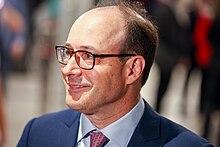REM de l'Est
[1] Spanning 32 km (19.88 mi) and 23 stations, the REM de l'Est would have expanded rapid transit coverage of Montreal's East Island, an area generally considered underserved by public transport.
[3] While polling indicated local favourability to the project, it was prominently criticized for its majority use of elevated rail, especially in a downtown section over René-Lévesque Boulevard, which generated concerns of urban disfigurement, fragmentation and noise pollution.
[8][9] Multiple times in 2018, the recently elected Coalition Avenir Québec (CAQ) provincial party, led by premier François Legault, promoted the possibility of expanding Montreal's Réseau express métropolitain (REM) light metro network, a key public transport project of the previous Liberal administration that had broken ground that same year.
[13] On May 6, 2019, the Quebec government formally instructed the CDPQ to study different scenarios for expanding the REM towards the suburban cities of Laval and Chambly, as well as implementing a structuring public transport network in eastern Montreal.
[19] Upon announcement of the REM de l'Est, many celebrated the planned introduction of rapid transit to the East Island's public transport offer, which consists mostly of bus lines.
[5] Tracks would have bordered Montreal's Chinatown to the north, with a station planned on a vacant lot next to one of the area's four paifangs, leading some critics to worry the structures would visually block an entrance to the neighbourhood.
[5] In a report, Montreal's public consultation office, the OCPM, warned the REM de l'Est would "scar" the Faubourgs sector in the Centre-Sud, an industrial and heavily trafficked area which the city hopes to revitalize.
[50][51] Supporters of an elevated REM de l'Est highlighted the potential improvement of eastern René-Lévesque Boulevard, perceived as car-heavy and unattractive, and the perspective of unique views of the city and the St. Lawrence River from aboard the train.
[7][55] Supporters of the REM de l'Est expected the system to reduce urban sprawl and car dependency in Greater Montreal and, thus, lower the city's greenhouse gas emissions (GHGs) and help mitigate climate change.
[61] Montreal mayor Valérie Plante and leaders from all three opposition parties in Quebec's National Assembly demanded that the ARTM and/or the city be more involved in negotiations surrounding the project.
[69] In the report, the ARTM argued the system only met a fraction of the transit needs of East Islanders, based on a 2013 estimation that only 12% of targeted riders commuted daily to downtown Montreal.
[73][63] "Social acceptability" of the REM de l'Est was a stated key concern of the Quebec and Montreal governments, and its lack thereof was eventually cited by them as the main reason behind the project's cancellation.
[4] On May 2, 2022, Quebec premier François Legault, along with Montreal mayor Valérie Plante, announced its government had decided to eliminate from the REM de l'Est's proposed network the downtown section running west of Dickson Street.
[74] According to Legault, the elevated stretch, which would have run over eastern René-Lévesque Boulevard and Notre-Dame Street, alongside Chinatown and across the Faubourgs sector and Morgan Park, lacked social acceptability.
[75][76] In his first public remarks after the announcement, the Caisse's CEO, Charles Emond, claimed the firm had offered Valérie Plante a seat at the negotiations table weeks prior and that she had been pleased.
[78] Some sources also claimed Legault's decision was motivated by a desire to avoid conflict with Valérie Plante before the upcoming 2022 Quebec general election, where his party hoped to make gains on Montreal Island.
[79] First details on the PSE included that it would be connected to the Metro's Green Line via Assomption station, rather than be directly linked to downtown Montreal, and that a subsequent second phase of the project would extend towards the city of Laval and the region of Lanaudière.
[80] The ARTM stated it would study multiple scenarios that had been discarded by CDPQ Infra, including abandoning automation, thus allowing trains to run at ground level and avoiding elevated structures, or burying a larger portion of the network.
[74] Provincial transport minister Chantal Rouleau also claimed 85% of the route would be maintained, while the Caisse's CEO, Charles Emond, speculated only 10% of the work remained before new calls for tenders could be initiated.
[75] However, on July 1, 2023, the ARTM's proposed project was revealed to be a $36 billion fully-underground light metro system, without a direct downtown link but with an extension of the REM de l'Est route towards the neighbourhood of Rivière-des-Prairies and the cities of Laval and Charlemagne.
[81] Christian Savard, director of the urbanist nonprofit Vivre en Ville, said the proposal seemed "more like a political battle against elevated structures than a reasoned approach by public transport experts".
[86] Its route is similar to that of the REM de l'Est, although it doesn't include a direct link to downtown Montreal and instead adds stations in Rivière-des-Prairies, Montréal-Est and the off-island suburbs of Terrebonne and Repentigny.
[91] at Bonaventure Mont-Saint-Hilaire line at Gare Centrale No choice of rolling stock had been announced by the time the REM de l'Est project was abandoned on May 2, 2023, as the deadline for bids was still months away.
[92] In the notice to the market released by CDPQ Infra, the description of the desired rolling stock was nearly identical to the one that had been made for the original REM, which employs Alstom Metropolis trains.





